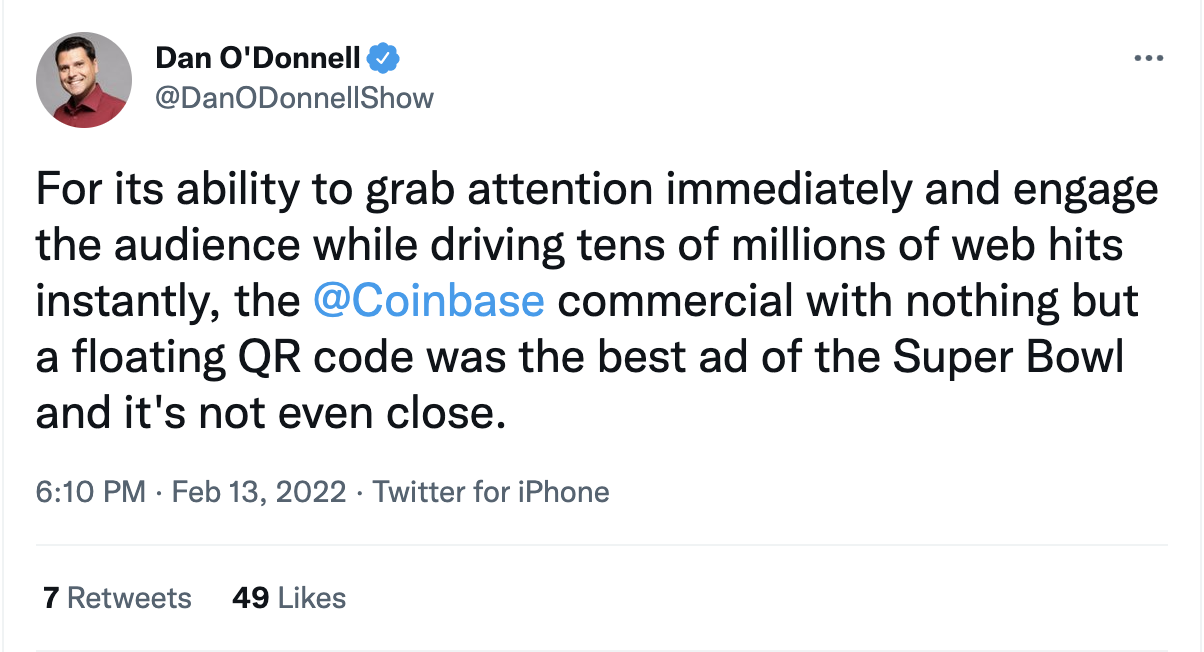It’s been over a week since the Super Bowl, and, if we’re being honest, we’ve already forgotten who won the big game. Full disclosure: The majority of our team didn’t even tune in to watch football — we, like the other 43% of viewers, were watching exclusively to see this year’s best (and weirdest) Super Bowl ads.
Now that all the buzz has died down, we’re diving into the biggest trends of this year’s Super Bowl ads to see what’s really resonating with audiences nationwide. With a hefty 6 million dollar price tag for a 30-second spot, this year’s most successful marketers captured the attention of Bengals, Rams and halftime show fans alike by pivoting from 2021 trends and embracing simplicity, levity and futurism.
Mum’s the word
If you had told us before the Super Bowl that one of this year’s top-performing ads would be 60 seconds of a floating QR code, we probably would’ve had some questions. But Coinbase’s Super Bowl debut defied advertising dos and don’ts, breaking through the barrage of branded messaging and earning 20 million unique scans within one minute after the commercial aired.
Most striking about this ad was the absence of verbal content. Coinbase married the nostalgia of the 90s bouncing DVD logo (you know the one) with the ubiquity of The Office pop culture references to pique viewers’ curiosity. Minutes after the ad ended, Twitter was abuzz with audience takes on the 60-second spot:
Once scanned, the QR code directed viewers to Coinbase’s website, where they were offered $15 worth of free Bitcoin and entry into a $3 million giveaway. The advertisement proved so successful that the app temporarily crashed, skyrocketing Coinbase to popularity as it rose from 186th place to 2nd in Apple’s App Store.
The takeaway? It’s okay to let your creative executions speak for themselves! The simplicity of this ad allowed the brand’s interactive CTA to take center stage, ensuring their message captivated audiences — even over the sea of star-studded Super Bowl ads.
(Way) out of home
While the pandemic still isn’t behind us, this year’s Super Bowl advertisers leaned into humor to help restore some semblance of normalcy for consumers. Well . . . if you count Guy Fieri and his lookalikes presiding over “The Land of Loud Flavors” as normal, that is.
In the 60-second Bud Light spot, Anheuser-Busch promoted their new hard sodas by introducing viewers to a new world where flavor reigns supreme. Capitalizing on Fieri’s self-proclaimed moniker, “Mayor of Flavortown,” and his status as a beloved internet meme, the ad gave audiences across the nation a hilarious breath of fresh air.
The success of Bud Light’s ad speaks to a larger trend in 2022 marketing. Unlike last year’s Super Bowl commercials, which were full of nods to the ongoing coronavirus pandemic and its effects on our communities, this year’s ads pivoted from the theme of resilience. Instead, advertisers gave audiences what we’ve been craving these last two years: an escape.
Everyone is exhausted from the near-constant stream of downbeat headlines, so offering a chance to explore a world vastly more whimsical than our own will help marketers reconnect with their audiences and bring much-needed levity into the lives of their consumers in 2022.
Back to the future
Brands didn’t just give audiences an escape during the Super Bowl — they completely reimagined our future. While 2021 ads shied away from exploring what our uncertain future might hold, this year’s Super Bowl marketers looked confidently toward a future gilded with hope and innovation.
Cryptocurrency and electric vehicles accounted for some of the most common product categories this year, but BMW’s Zeus & Hera spot managed to capture exactly how revolutionary — and exciting — our next chapter could be. By juxtaposing ancient mythology with the power of invention in their 60-second ad, BMW energized consumers to look forward not with dread, but with a newfound confidence in our future.
As we continue adjusting to our “new normal,” this ad should serve as the blueprint for how marketers should navigate consumers’ feelings toward the future. Using Zeus’ frustrations with the 21st Century to connect with audiences’ struggles acclimating to life between variants, BMW captured viewers’ real fears about the future without a single mention of the pandemic.
Showcasing how people’s talents shine above the technology they wield, BMW’s message to audiences was clear: We have the power to make our future a bright one. After two years of “unprecedented times,” consumers are struggling to reclaim control over what their future holds. That’s why in 2022, marketers should similarly empower their consumers by highlighting human agency in the face of change throughout their messaging.
Super bold
Generating over $545 million in ad revenue, the Super Bowl is undoubtedly advertising’s biggest stage. As this year’s Super Bowl attracted a record-breaking 112.3 million viewers, marketers need to understand what advertising trends resonated with audiences — and how to implement them in your own communications.
Leveraging simplicity, levity and futurism in your 2022 marketing strategies is key to propelling your brand to the forefront of audience buzz. Keeping these trends in mind when planning out your company’s creative executions will ensure you continue breaking through the clutter while establishing your brand as a vanguard of better days ahead.
What did we miss? Tell us about it on Twitter!

